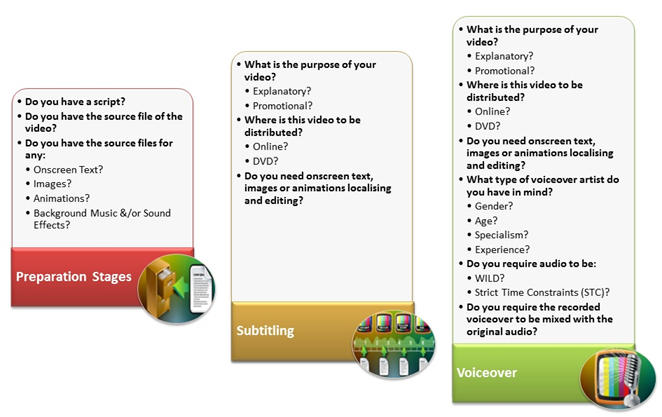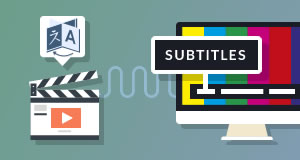Back in October, I wrote a post suggesting some of the best ways to increase international sharing of multilingual videos in which I discussed the need to either subtitle or dub video content into foreign languages.
Since then, I have been asked on numerous occasions which is the most appropriate option: video subtitling or multilingual voiceover? This post will discuss the differences between the two processes and give examples of when they are more beneficial. Before making a decision on whether to use subtitling or voiceover, it is really important that you understand the various stages included in each of the processes, as they are more complex than you would initially think.
Preparation
The initial preparation stage starts by asking a number of questions in order to clarify the intended use of the video: promotional or explanatory? The intended output of the video: web-based or for DVD distribution? What is included in the video that will also need localising: onscreen text, images, or animations? What sort of budget can you assign to this project?
It is incredibly important to have at least an idea of the amount of money you can dedicate to videos as part of your international marketing campaign. As there are so many possibilities for creating multilingual videos, you would be surprised at the costs that can come with them. I will be honest with you as well: voiceover is significantly more expensive due to the complexity of the process, as you will soon see.
At this stage you will also need to ensure that you have access to original source files in order to reduce the risk of incurring additional charges for file conversion or supplementary engineering processes. If you already have a script, preferably a time-coded script, then that will also reduce costs.
Video subtitling
When it comes to subtitling there are a couple of different processes which can be implemented depending of the final intended use if the video.
Web-based videos for YouTube, Youku, Rutube etc. simply need a subtitle document uploading to the platform alongside the video. The viewer can then easily select the language they want from the closed-caption options in the bottom right hand side of the video. You can upload as many subtitle documents for the languages you require, and as long as they are properly time-coded then they are a low-value, efficient option.
It is also worth mentioning here that you can help optimise web-based videos by including relevant keywords in the subtitle document which are also picked up in SERPs to help maximise the visibility of your video internationally. You do not get this option when it comes to voiceover!
If your video is intended for DVD distribution then you could have subtitles burnt-in to the video file where they are constantly visible throughout the entirety of the video and cannot be turned-off by the viewer. In this instance you would need one version of the video with subtitles for each of the languages you require.
For DVD you could also make use of closed captions which will be selected by the viewer from a menu prior to the start of the video. This would be of benefit for internal training videos where your company has an international presence. One DVD with all your required languages could be produced and distributed to your in-country offices quite easily. For “How to”, instructional or explanatory videos then subtitling will suffice.
Voiceover
The use of multilingual voiceover is much more appropriate for marketing or promotional videos as it adds a more personal element to the overall feel of the video. However, the multilingual voiceover process is much more complex than subtitling making it more expensive and time consuming overall.
The hiring of professional voiceover artists, recording studios and sound engineers are usually charged by the hour meaning that they all add to the final cost of the project. Depending on the language, experience or specialism of the voiceover artist will also affect the rate that they charge, and if your video is intended to promote your products then often you will have to pay buyout fees to the voiceover artist for their permission to use their recording in the public arena.
Recordings can be carried out in one of two ways either WILD, which does not require time-coding as the onscreen visuals do not need to match the audio, or STC (Strict Time Constraints), which would be used if you needed to dub the speech of those people featuring in the original video. For STC time-coding would be essential, and the use of a Linguistic Director would also be recommended to ensure that the voiceover artists were adhering to the time-codes as accurately as possible. These are all things that you should contemplate during the preparation stage.
Once the recording is complete there are several editing stages that should be carried out by an audiovisual engineer, especially if you not have the in-house capabilities to conduct them yourself. These can include, but are not limited to, cleaning and editing of the recorded audio file, remixing of the audio to incorporate any music or sound effects used in the original video, and the encoding of the audio to the video so that the final version plays through smoothly.
On-screen text, images and animations
When it comes to creating multilingual versions of existing videos it is important to decide whether you just want the audio content translating, or whether you require a complete replica of the original to be produced in your required language(s).
Localising onscreen text, images and animation is certainly a great idea if you want to recreate the original video as closely as possible, but for this audiovisual agencies will require all source files for any additional materials used in order to be able to edit them appropriately. Of course, additional engineering charges will apply and if you cannot provide the source files, then the costs will increase as engineers will have to attempt to create any images etc. from scratch.
Controlling your audiovisual budget
As I have said from the beginning, it is really important that you have an idea of the budget you can allocate to audiovisual projects as this will really effect the possibilities you have available to you. Providing an audiovisual agency with at least an indication of what you can afford will allow them to propose appropriate solutions to fulfil your needs. For example, if you choose to go with multilingual voiceover, agencies can select voiceover artists with lower hourly rates to reduce costs, or if you are able to complete some of the engineering stages in-house then you would be minimising the cost of outsourcing them.
It is also a good idea to start small by translating a few different videos into one language instead of one video into several languages. This will reduce the risk of incurring minimum charges which are often applied to videos which are shorter in length.
Checklist
The main purpose of this post was to demonstrate the various steps which can be involved in producing multilingual versions of your visual content. People are often surprised at the complexity of the processes required for video subtitling and multilingual voiceover, and in turn the costs involved. Take each of the steps I have outlined and add a cost to it. Multiply this by the number of videos and/or languages you require. Now compare this to the budget that you had in mind. Does the proposed cost exceed your budget? In my experience working with clients, yes it does!
I have created a quick checklist of the most important questions you should be asking yourself before looking into audiovisual translation services. I hope you find it useful and that it gives you a better understanding of just what is involved in subtitling and voiceover projects.
Emily MacKenzie
Latest posts by Emily MacKenzie (see all)
- What is SEO-localisation? - May 11, 2018
- Agile processes for continuous delivery: A focus on SEO-localisation - May 11, 2018
- E-book review: Undertaking SEO-localisation in a world of continuous delivery - May 11, 2018






